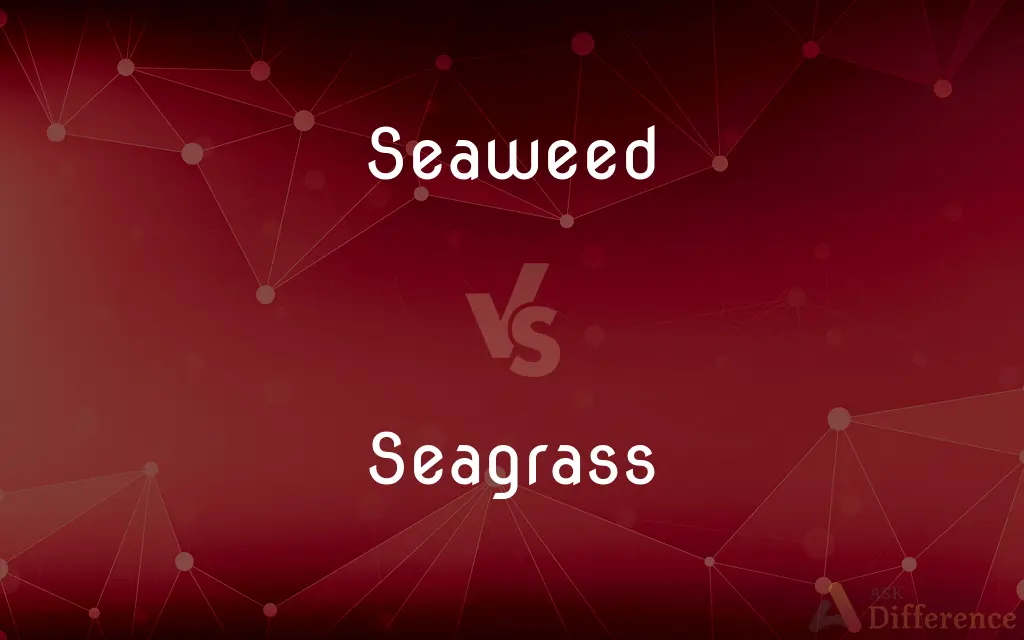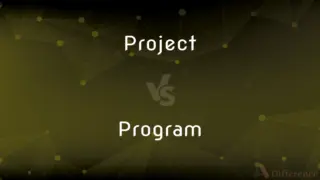Seaweed vs. Seagrass — What's the Difference?
By Urooj Arif & Fiza Rafique — Updated on March 14, 2024
Seaweed refers to diverse marine algae, thriving in a range of water bodies, whereas seagrass denotes specific flowering plants adapted to underwater life.

Difference Between Seaweed and Seagrass
Table of Contents
ADVERTISEMENT
Key Differences
Seaweed encompasses a wide variety of marine algae, including species that reside in saltwater environments, from deep oceans to shallow coasts. On the other hand, seagrass belongs to a group of flowering plants that have adapted to live fully submerged in marine environments.
While seaweed primarily reproduces through spores and fragmentation, seagrass can reproduce both through the production of flowers and seeds, and via rhizome extension. This reproductive flexibility allows seagrass to form extensive underwater meadows that are biodiverse habitats.
Seaweed is often harvested for food, agar, and carrageenan, playing a significant role in human cuisine and industry. Its ability to grow rapidly and in a variety of conditions makes it a valuable resource. In contrast, seagrass is not commonly used for human consumption but is invaluable for its ecological role in carbon sequestration, shoreline stabilization, and as a key element in marine food webs.
Despite their differences, both seaweed and seagrass are vital to the health of marine ecosystems. Seaweed acts as a major producer of oxygen and a food source for a wide range of marine organisms, while seagrass meadows serve as critical habitats for many species, including endangered ones.
Comparison Chart
Type
Marine algae
Flowering plants
ADVERTISEMENT
Habitat
Saltwater environments
Submerged marine environments
Structure
Lacks true roots, stems, and leaves
Has true roots, stems, and leaves
Reproduction
Spores and fragmentation
Flowers and seeds, and rhizome extension
Uses
Food, agar, carrageenan
Ecological benefits
Compare with Definitions
Seaweed
Seaweed serves as a crucial oxygen producer in marine ecosystems.
The great kelp forests are underwater havens for marine life.
Seagrass
Flowering plants adapted to live underwater in marine environments.
Turtle grass is a common type of seagrass in tropical seas.
Seaweed
A key component of some traditional cuisines.
In Korean cuisine, seaweed is a staple for soups and salads.
Seagrass
Forms extensive beds that serve as critical habitats for marine life.
Seagrass meadows are nursery grounds for juvenile fish.
Seaweed
Thrives in a variety of marine environments.
Seaweed can be found from the deep sea to rocky coastal shores.
Seagrass
Plays a significant role in carbon sequestration.
Seagrass beds are efficient at trapping carbon dioxide from the atmosphere.
Seaweed
A diverse group of marine algae that can range from microscopic to large kelp.
Sushi often includes nori, a type of seaweed.
Seagrass
Reproduces through flowers and seeds, unique among submerged aquatic vegetation.
Seagrass flowers are pollinated underwater.
Seaweed
Harvested for its agar and carrageenan content.
Agar, derived from seaweed, is used in microbiological media.
Seagrass
Provides stabilization for marine sediment.
The root systems of seagrass help prevent coastal erosion.
Seaweed
Seaweed, or macroalgae, refers to thousands of species of macroscopic, multicellular, marine algae. The term includes some types of Rhodophyta (red), Phaeophyta (brown) and Chlorophyta (green) macroalgae.
Seagrass
Seagrasses are the only flowering plants which grow in marine environments. There are about 60 species of fully marine seagrasses which belong to four families (Posidoniaceae, Zosteraceae, Hydrocharitaceae and Cymodoceaceae), all in the order Alismatales (in the class of monocotyledons).
Seaweed
Large algae growing in the sea or on rocks below the high-water mark
Seaweed glistened on the rocks
Seaweeds abound on most shores
Seagrass
Any of various submersed marine grasslike plants that grow in shallow coastal waters.
Seaweed
Any of numerous marine algae, such as a kelp, rockweed, or gulfweed.
Seagrass
Any of various grass-like marine plants that grow underwater in salt water.
Seaweed
A mass of such algae.
Seagrass
Any of various seaweeds that grow underwater in shallow beds;
Seagrass provides a protective environment in which young fish can develop
Seaweed
Any of numerous marine plants and algae, such as a kelp.
Seaweed
(by extension) Any of various fresh water plants and algae.
Seaweed
Popularly, any plant or plants growing in the sea.
Seaweed
Any marine plant of the class Algæ, as kelp, dulse, Fucus, Ulva, etc.
Seaweed
Plant growing in the sea, especially marine algae
Common Curiosities
Can seaweed be eaten?
Yes, many types of seaweed are edible and nutritious, used in cuisines worldwide.
Are seagrass and seaweed the same?
No, seagrass are flowering plants that live underwater, while seaweed are marine algae.
What is the largest type of seaweed?
The largest type of seaweed is the giant kelp, which can grow up to 60 meters.
Why is seagrass important?
Seagrass is crucial for carbon sequestration, habitat provision, and shoreline stabilization.
What are the benefits of seaweed?
Seaweed provides oxygen, food, and is used in various industries for its agar and carrageenan.
Can seaweed grow in freshwater?
Seaweed primarily grows in saltwater environments, though some species can tolerate brackish waters.
Do seagrass beds help with climate change?
Yes, by sequestering carbon dioxide, seagrass beds mitigate the effects of climate change.
Are there any uses for seagrass in human products?
While not commonly used for consumption, seagrass is sometimes utilized in furniture and building materials.
What challenges do seaweed and seagrass face?
They face threats from pollution, climate change, and habitat destruction.
Is seaweed farming sustainable?
Seaweed farming is considered sustainable and beneficial for the environment, absorbing CO2 and improving water quality.
How do seagrass meadows benefit marine life?
They offer habitat, food, and nursery grounds for diverse marine organisms.
How do seagrass beds stabilize the seabed?
Their roots bind the sediment, reducing erosion and stabilizing the seabed.
Can seaweed and seagrass coexist?
Yes, they can coexist in marine ecosystems, each playing unique ecological roles.
Share Your Discovery

Previous Comparison
Project vs. Program
Next Comparison
Formatting vs. EditingAuthor Spotlight
Written by
Urooj ArifUrooj is a skilled content writer at Ask Difference, known for her exceptional ability to simplify complex topics into engaging and informative content. With a passion for research and a flair for clear, concise writing, she consistently delivers articles that resonate with our diverse audience.
Co-written by
Fiza RafiqueFiza Rafique is a skilled content writer at AskDifference.com, where she meticulously refines and enhances written pieces. Drawing from her vast editorial expertise, Fiza ensures clarity, accuracy, and precision in every article. Passionate about language, she continually seeks to elevate the quality of content for readers worldwide.
















































